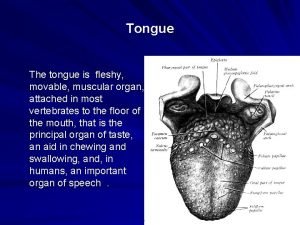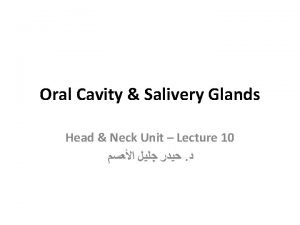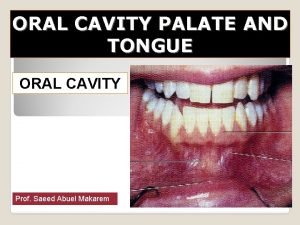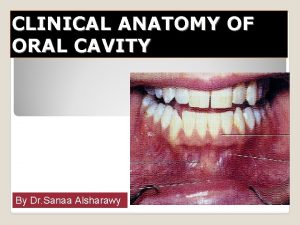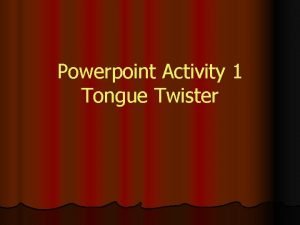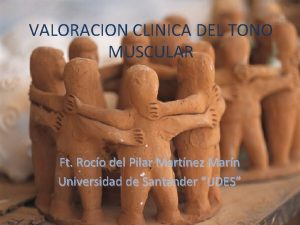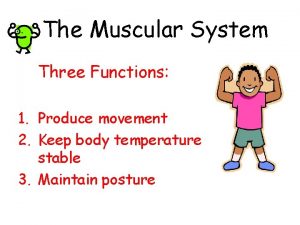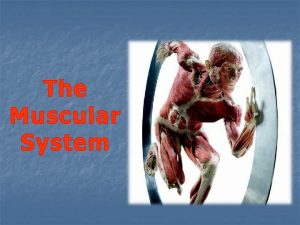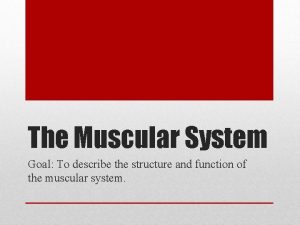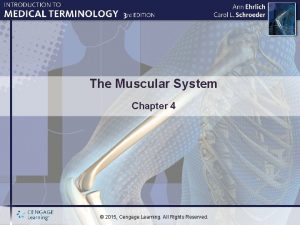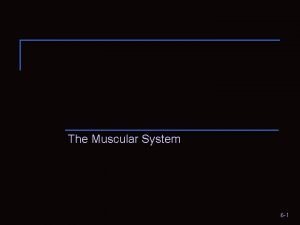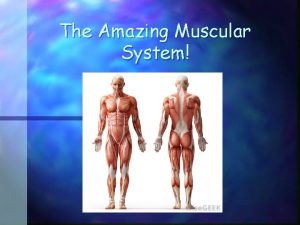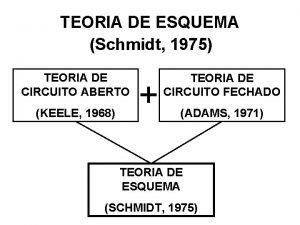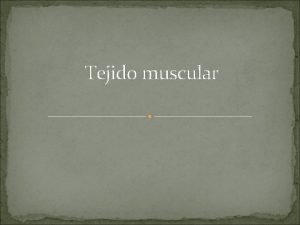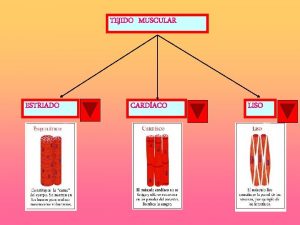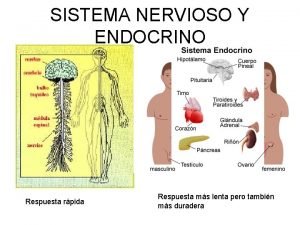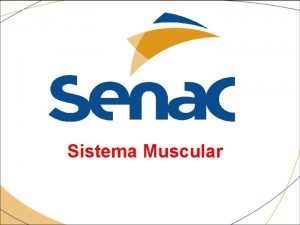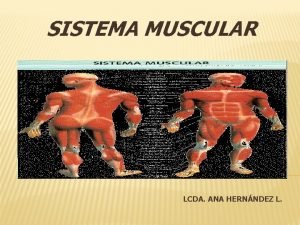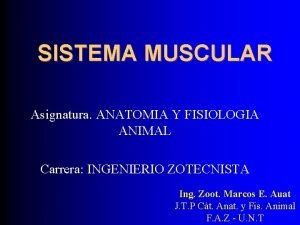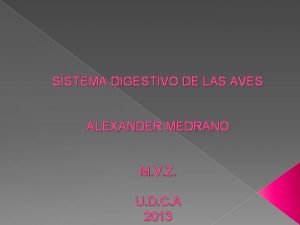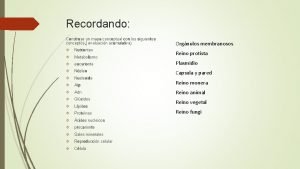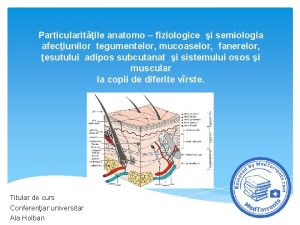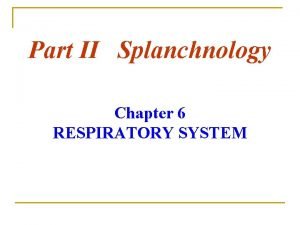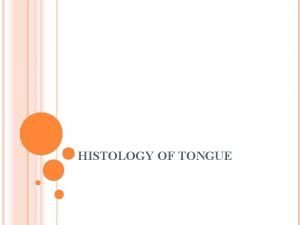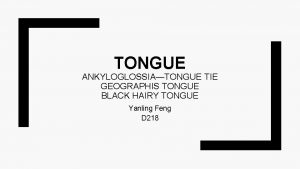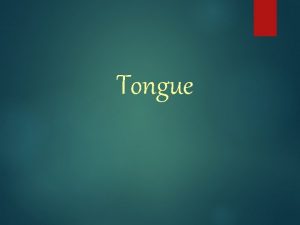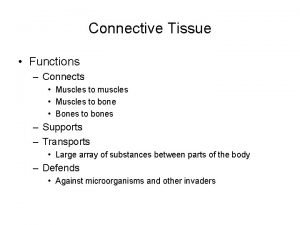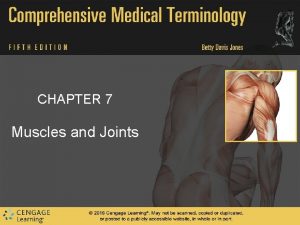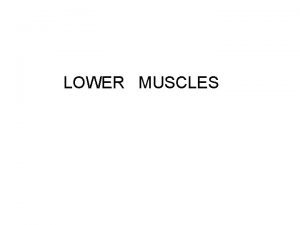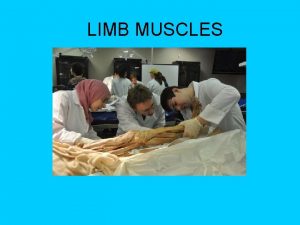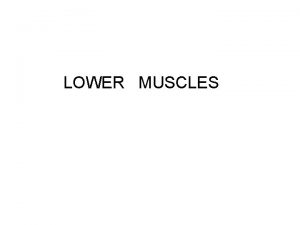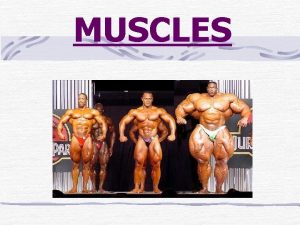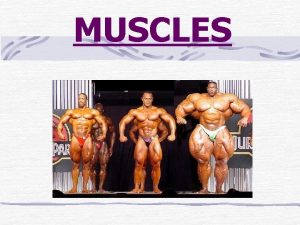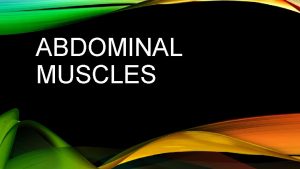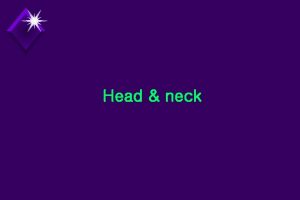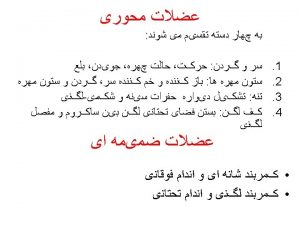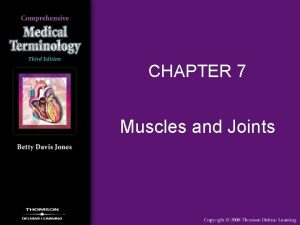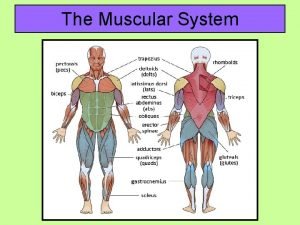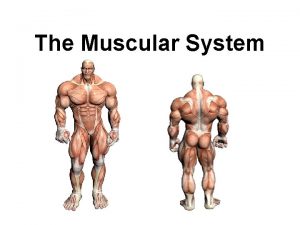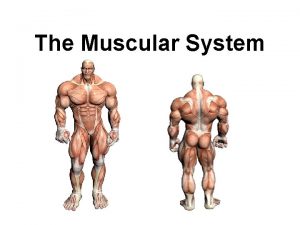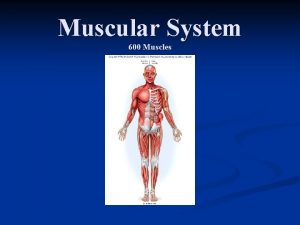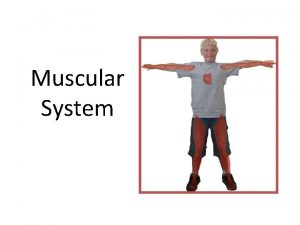TONGUE MUSCLES INNERVATIONS INTRODUCTION Tongue is a muscular



























- Slides: 27

TONGUE MUSCLES & INNERVATIONS

INTRODUCTION - Tongue is a muscular organ Situated in the floor of the mouth FUNCTION - Taste Speech - Mastication - Deglutition

EXTERNAL FEATURES - Tongue has A Root A tip ROOT A body - Is attached to the mandible and soft palate above and hyoid bone below. - These attachments prevent the swallowing of the tongue. -In between the 2 bones it is related to the geniohyoid and mylohyoid muscles. TIP - Of the tongue forms the anterior free end which lies behind the upper incisor teeth. BODY - Has A curved upper surface or dorsum

DORSUM - Is convex in all directions - Is divided into Oral part (ant 2/3 rd) Pharyngeal part (post 1/3 rd) Posterior most part of the tongue Sulcus terminalis V shaped sulcus that separates the oral and pharyngeal parts. Foramen caecum the 2 limbs of the V meet at the median pit. They run laterally and forwards up to the palatoglossal arches The foramen caecum represents the site from which the thyroid diverticulum grows down in the embryo.

Inferior or ventral surface - Is confined to the oral part only - Inferior surface is covered with a smooth mucous membrane, which shows a median fold called frenulum linguae. - On either side of the frenulum there is a prominence produced by the deep lingual veins. - More laterally there is a fold called the plica fimbriata that is directed forwards and medially towards the tip of the tongue.

ORAL AND PHARYNGEAL PARTS OF THE TONGUE DIFFER IN THEIR DEVELOPMENT, TOPOGRAPHY, STRUCTURE AND FUNCTION. ORAL PART - Or papillary part of the tongue - Lies in the mouth (floor of the mouth) - Lies in front of the palatoglossal arches and the sulcus terminalis. - Its margins are free and in contact with the gums and teeth. - Just in front of the palatoglossal arch each margins shows 4 – 5 vertical folds, named foliate papillae. - Superior surface of the oral part shows a median furrow and is covered with papillae which make it rough.

PHARYNGEAL PART - Also called lymphoid part of the tongue - Lies in the pharynx - Lies behind the palatoglossal arches and the sulcus terminalis. - Its posterior surface (called base of the tongue) forms the anterior wall of the oropharynx. - The mucous membrane has no papillae, but has many lymphoid follicles that collectively constitute the lingual tonsil. - Mucous glands are also present.

POSTERIOR MOST PART OF THE TONGUE - Is connected to the epiglottis by 3 folds of mucous membrane. - These are the median glossoepiglottic fold and the right and left lateral glossoepiglottic folds. - On either side of the median fold there is a depression called vallecula. - The lateral folds separate the vaellecula from the piriform fossa.

MUSCLES OF THE TONGUE - Middle fibrous septum divides the tongue into right and left halves. Intrinsic muscles Superior longitudinal Inferior longitudinal Transverse Vertical Extrinsic muscles Genioglossus Hyoglossus Styloglossus Palatoglossus

INTRINSIC MUSCLES - Occupy the upper part of the tongue - Are attached to the submucous fibrous layer and to the median fibrous septum. - They alter the shape of the tongue Superior longitudinal muscle - Lies beneath the mucous membrane. - It shortens the tongue and makes its dorsum concave Inferior longitudinal muscle - Is a narrow band lying close to the inferior surface of the tongue between the styloglossus and the hyoglossus - It shortens the tongue and makes the dorsum convex.

Transverse muscle - Extends from the median septum to the margins. - It makes the tongue narrow and elongated. Vertical muscle - Is found at the borders of the anterior part of the tongue. - It makes the tongue broad and flattened.

EXTRINSIC MUSCLES - Connect the tongue to the Mandible via genioglossus Hyoid bone through hyoglossus Styloid process via styloglossus Palate via palatoglossus

GENIOGLOSSUS - Fan shaped muscle - Which forms the main bulk of the tongue - It arises from the upper genial tubercle of the mandible - From here the fibers fan out and run backwards - Upper fibers are inserted into the tip - Middle fibers are inserted into dorsum - Lower fibers into hyoid bone. - Upper fibers restract the tip - Middle fibers depress the tongue - Lower fibers pull the posterior part of the tongue forwards and thus protrude the tongue from the mouth.

HYOGLOSSUS - Is an important landmark in the submandibular region - Origin whole length of greater cornua and lateral part of body of hyoid bone. - Fibers run upwards and forwards - Insertion side of tongue between styloglossus and inferior longitudinal muscle of tongue - Nerve supply hypoglossal nerve - Action depresses tongue, makes dorsum convex and retracts the protruded tongue.

STYLOGLOSSUS - Origin tip and adjacent part of the anterior surface of the styloid process as well as from the upper end of the stylohyoid ligament. - Fibers pass downwards and forwards - Insertion into the side of the tongue, intermingling with the fibers of the hyoglossus - Nerve supply hypoglossal nerve - Action during swallowing it pulls the tongue upwards and backwards.

PALATOGLOSSUS - Origin oral surface of palatine aponeurosis - Fibers descends in the palatoglossal arch - Insertion Side of the tongue (at the junction of oral and pharyngeal parts) - Nerve supply cervical part of accessory nerve - Action pulls up the root of the tongue, approximates the palatoglossal arches and thus closes the oropharyngeal isthmus.

ARTERIAL SUPPLY - Chiefly derived from lingual artery - A branch of external carotid artery - Root of the tongue is also supplied by the tonsillar and ascending pharyngeal arteries.

VENOUS DRAINAGE - Veins of the tongue are called vena comitantes. - The arrangement of vena comitantes is variable. - 2 vena comitantes accompany the lingual artery and 1 vena comitantes accompanies the hypoglossal nerve. - The deep lingual vein is the largest and the principal vein of the tongue. - It is visible on the inferior surface of the tongue. - It runs backwards and crosses the genioglossus and the hyoglossus below the hypoglossal nerve. - These veins unite at the posterior borders of the yoglossus to form lingual vein which ends either in the common facial vein or in the internal jugular vein.

LYMPHATIC DRAINAGE - Tip of the tongue drains bilaterally to the submental nodes - Right and left halves of the remaining part of the anterior 2/3 rd of the tongue drains unilaterally to the submandibular nodes. - Few central lymphatics drain bilaterally to the same nodes. - Posterior 1/3 rd of the tongue drains bilaterally to the jugulo-omohyoid nodes, these are known as the lymph nodes of the tongue.

NERVE SUPPLY OF THE TONGUE Nerve supply Anterior 2/3 rd Posterior 1/3 rd Posterior valleculla Sensory Lingual Glossopharyngeal Internal laryngeal branch of vagus Tatse Chorda tympani vallate papillae Developme nt epithelium of most part or except Glossopharyngeal including Internal laryngeal branch of the vallate papillae vagus st Third arch which forms large Fourth arch which forms the Lingual swellings of 1 arch Tuberculum impar which ventral part of small doral part of soon disappears hypobranchial eminence

HISTOLOGY - Bulk of the muscle is made up of striated muscles - Mucous membrane consists of a layer of CT (corium), lined by stratified squamous epithelium. Oral part of dorsum is thin, forms papillae and is adherent to the muscles. Pharyngeal part of the dorsum is very rich in lymphoid follicles. Inferior surface is thin and smooth. Numerous glands, both mucous and serous lie deep to the mucous membrane.

TASTE BUDS Are most numerous on the sides of the vallate papillae and on the walls of the surrounding sulci. They are numerous over foliate papillae and posterior one third of the tongue Sparsely distributes on the fungiform papillae, soft palate, epiglottis and pharynx. No taste buds on the mid dorsal region of the oral part of the tongue.

PAPILLAE OF TONGUE - Papillae are projections of the mucous membrane of corium which give the anterior 2/3 rd s of the tongue its characteristic roughness. - They are of the following types 1. Vallate or circumvallate papillae • These are large in size 1 -2 mm in diameter and are 8 -12 in number. • They are situated immediately in front of the sulcus terminalis. • Each papillae are cylindrical projection surrounded by a circular sulcus. • The walls of the papilla are raised above the surface.

2. Fungiform papillae • Are numerous • Near the tip and margins of the tongue, but some of them are scattered over the dorsum. • These are smaller than the vallate papillae but larger than the filliform papillae. • Each papilla consists of a narrow pedicle and a large rounded head. • They are distinguished by their bright red colour.

3. Filliform papillae • Conical papilla • Cover the presulcal area of the dorsum of the tongue and gives it a characteristic velvety appearance. • They are the smallest and most numerous of the lingual papillae. • Each are pointed and covered with keratin • The apex is often split into filamentous processes.

DEVELOPMENT OF TONGUE I. EPITHELIUM Anterior 2/3 rd From 2 lingual swellings and one tuberculum impar which arise from the first branchial arch Tuberculum impar soon disappears Therefore supplied by lingual nerve (post trematic) and chorda tympani (pretrematic) Posterior 1/3 rd From cranial large part of the hypobranchial eminence, i. e. from the third arch. Therefore supplied by the glossopharyngeal nerve. Posterior most part From 4 th arch Therefore, supplied by vagus nerve I. MUSCLES Muscles develop from the occipital myotomes which are supplied by the hypoglossal nerve I. CONNECTIVE TISSUE CT develops from the local mesenchyme.

THANK YOU
 Spinal cord anatomy
Spinal cord anatomy Plyometrics disadvantages
Plyometrics disadvantages Papilla
Papilla Tongue muscles innervation
Tongue muscles innervation Specialized mucosa
Specialized mucosa Genioglossus muscle
Genioglossus muscle Sensory supply to the soft palate
Sensory supply to the soft palate Tongue twister ppt
Tongue twister ppt Evaluacion tono muscular ashworth
Evaluacion tono muscular ashworth How do muscles work in pairs
How do muscles work in pairs Primary functions of the muscular system
Primary functions of the muscular system Function of muscular system
Function of muscular system Chapter 4 the muscular system
Chapter 4 the muscular system Muscular system figure
Muscular system figure Thyrohyoid membrane
Thyrohyoid membrane Simple muscular system diagram
Simple muscular system diagram Teoria de esquema de schmidt
Teoria de esquema de schmidt Tejido muscular
Tejido muscular Tejido muscular cardiaco partes
Tejido muscular cardiaco partes Sistema nervioso central
Sistema nervioso central Msculos
Msculos Sistema muscular funciones
Sistema muscular funciones Tono muscular fisiologia
Tono muscular fisiologia Funcion de la molleja
Funcion de la molleja Balance muscular
Balance muscular Diferenciación celular mapa conceptual
Diferenciación celular mapa conceptual Rahitizm
Rahitizm Vestibule of larynx
Vestibule of larynx


